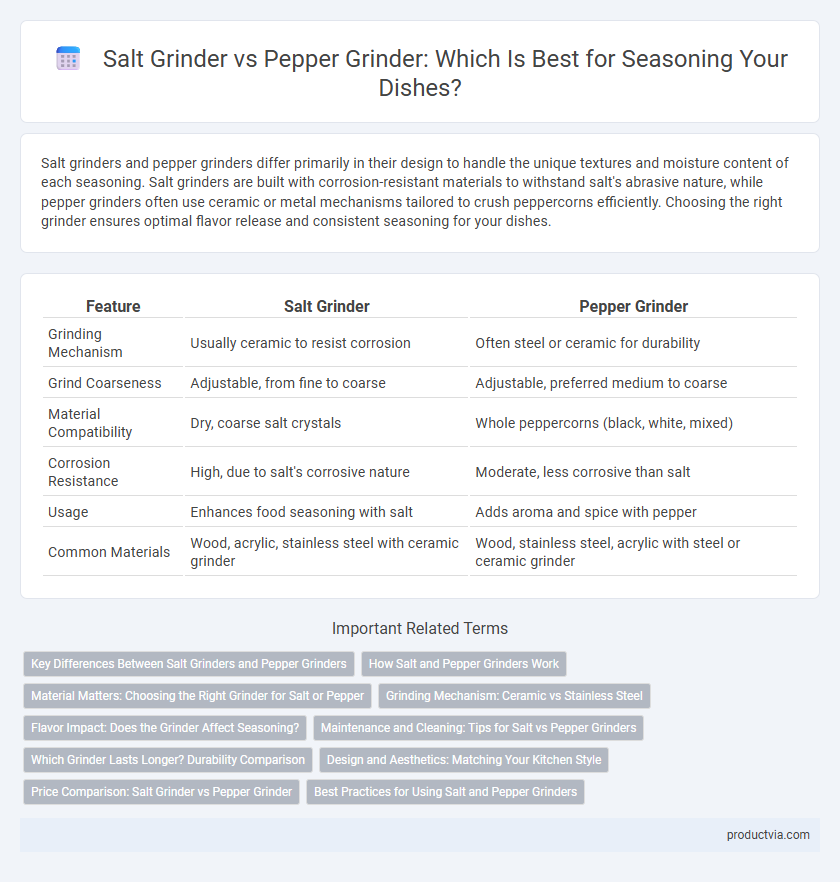Salt grinders and pepper grinders differ primarily in their design to handle the unique textures and moisture content of each seasoning. Salt grinders are built with corrosion-resistant materials to withstand salt's abrasive nature, while pepper grinders often use ceramic or metal mechanisms tailored to crush peppercorns efficiently. Choosing the right grinder ensures optimal flavor release and consistent seasoning for your dishes.
Table of Comparison
| Feature | Salt Grinder | Pepper Grinder |
|---|---|---|
| Grinding Mechanism | Usually ceramic to resist corrosion | Often steel or ceramic for durability |
| Grind Coarseness | Adjustable, from fine to coarse | Adjustable, preferred medium to coarse |
| Material Compatibility | Dry, coarse salt crystals | Whole peppercorns (black, white, mixed) |
| Corrosion Resistance | High, due to salt's corrosive nature | Moderate, less corrosive than salt |
| Usage | Enhances food seasoning with salt | Adds aroma and spice with pepper |
| Common Materials | Wood, acrylic, stainless steel with ceramic grinder | Wood, stainless steel, acrylic with steel or ceramic grinder |
Key Differences Between Salt Grinders and Pepper Grinders
Salt grinders feature ceramic or stainless steel mechanisms resistant to corrosion from salt crystals, while pepper grinders use steel or ceramic materials designed to crush peppercorns without dulling. Salt grinders often have larger, more adjustable grind settings to accommodate different salt crystal sizes, whereas pepper grinders provide finer, more consistent grinding suited for peppercorns. The internal design of salt grinders minimizes moisture buildup, preventing clumping, which is less of a concern in pepper grinders due to the drier nature of peppercorns.
How Salt and Pepper Grinders Work
Salt grinders use ceramic or stainless steel mechanisms designed to crush coarse salt crystals without corroding, ensuring consistent granule size for even seasoning. Pepper grinders typically feature adjustable burrs or blades that crush peppercorns to the desired coarseness, enhancing flavor release and aroma. Both grinders operate by turning a top or side knob that rotates the grinding mechanism, allowing precise control over seasoning texture.
Material Matters: Choosing the Right Grinder for Salt or Pepper
Salt grinders typically require corrosion-resistant materials such as stainless steel or ceramic to prevent rust and preserve flavor, while pepper grinders can use hardened steel or ceramic for effective crushing. Ceramic grinders are preferred for salt due to their durability against abrasiveness and moisture, whereas steel grinders excel in handling pepper's robust grains and oils. Selecting the right grinder material ensures optimal performance and longevity tailored to the specific seasoning needs.
Grinding Mechanism: Ceramic vs Stainless Steel
Salt grinders typically use ceramic grinding mechanisms because ceramic resists corrosion and prevents salt clumping, ensuring consistent grinding performance and durability. Pepper grinders, on the other hand, often utilize stainless steel mechanisms due to their strength and ability to handle the harder peppercorns without dulling over time. Choosing between ceramic and stainless steel grinding mechanisms depends on balancing corrosion resistance and durability with the type of seasoning, optimizing seasoning freshness and texture.
Flavor Impact: Does the Grinder Affect Seasoning?
Salt grinders and pepper grinders both influence the flavor impact of seasoning by controlling grind size, which affects texture and flavor release; coarser salt crystals provide bursts of saline taste, while finely ground pepper delivers a more intense, evenly distributed spice. The type of grinder mechanism, such as ceramic for salt to prevent corrosion and steel for pepper to maintain sharpness, also impacts the consistency and freshness of the seasoning. Ultimately, choosing the right grinder enhances the sensory experience by optimizing the seasoning's flavor potency and balance in dishes.
Maintenance and Cleaning: Tips for Salt vs Pepper Grinders
Salt grinders require regular cleaning to prevent moisture buildup and clumping, often using a dry brush or cloth to wipe the interior and grinding mechanism. Pepper grinders benefit from occasional disassembly and thorough cleaning with warm, soapy water to remove oil residues that can affect flavor and operation. Both types should be kept dry and free of debris to ensure optimal performance and longevity of the grinding mechanism.
Which Grinder Lasts Longer? Durability Comparison
Salt grinders often have ceramic or stainless steel mechanisms designed to resist corrosion caused by salt's moisture and abrasiveness, resulting in longer-lasting durability. Pepper grinders typically use steel or ceramic burrs that endure frequent use but can wear down faster than salt grinders if not maintained properly. Overall, salt grinders tend to last longer due to their corrosion-resistant materials, while pepper grinders require more regular upkeep to maintain optimal performance.
Design and Aesthetics: Matching Your Kitchen Style
Salt grinders often feature clear glass or acrylic bodies to showcase crystalline salt, complementing minimalist or modern kitchen designs, while pepper grinders typically use darker woods or metals, adding a rustic or industrial touch. The choice of material and finish directly influences how well the grinder integrates with kitchen decor, with stainless steel options offering a sleek, contemporary look suitable for high-end culinary spaces. Selecting grinders with coordinated shapes and complementary colors enhances visual harmony, making them both functional tools and stylish countertop accents.
Price Comparison: Salt Grinder vs Pepper Grinder
Salt grinders generally have a lower price point compared to pepper grinders due to the simpler grinding mechanism required for salt crystals. Pepper grinders often include more durable materials and adjustable settings to handle the tougher, oilier peppercorns, which can increase their cost. When choosing between the two, consider that salt grinders may offer better affordability, while pepper grinders provide enhanced functionality and longevity.
Best Practices for Using Salt and Pepper Grinders
Salt grinders require coarser, non-caking salt crystals for optimal grinding and consistent seasoning, while pepper grinders function best with whole peppercorns to preserve aroma and flavor. Always clean grinders regularly and avoid mixing salt and pepper in the same device to prevent clogging and maintain distinct taste profiles. Adjust the grind size according to the dish for finer or coarser seasoning control, ensuring balanced flavor enhancement.
Salt grinder vs Pepper grinder for seasoning Infographic

 productvia.com
productvia.com